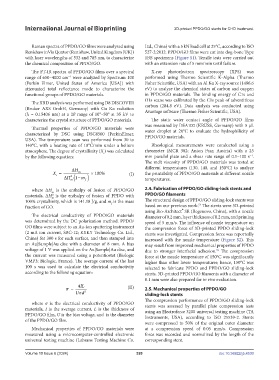Page 328 - IJB-10-6
P. 328
International Journal of Bioprinting 3D-printed PPDO/GO stents for CHD treatment.
Raman spectra of PPDO/GO films were analyzed using Ltd., China) with a 5 kN load cell at 25°C, according to ISO
Renishaw inVia Qontor (Renishaw, United Kingdom [UK]) 527-2:2012. PPDO/GO films were cut into dog-bone Type
with laser wavelengths of 532 and 785 nm, to characterize 1BB specimens (Figure S1). Tensile tests were carried out
the chemical composition of PPDO/GO. with an extension rate of 5 mm/min until failure.
The FT-IR spectra of PPDO/GO films over a spectral X-ray photoelectron spectroscopy (XPS) was
range of 650–4000 cm were analyzed by Spectrum 100 performed using Thermo Scientific K-Alpha (Thermo
−1
(Perkin Elmer, United States of America [USA]) with Fisher Scientific, USA) with an Al Kα X-ray source (1486.6
attenuated total reflectance mode to characterize the eV) to analyze the chemical states of carbon and oxygen
functional groups of PPDO/GO materials. in PPDO/GO materials. The binding energy of C1s and
O1s scans was calibrated by the C1s peak of adventitious
The XRD analysis was performed using D8 DISCOVER
(Bruker AXS GmbH, Germany) with Cu Kα radiation carbon (284.8 eV). Data analysis was conducted using
Avantage software (Thermo Fisher Scientific, USA).
(λ = 0.15406 nm) at a 2θ range of 10°–50° at 35 kV to
characterize the crystal structure of PPDO/GO materials. The static water contact angle of PPDO/GO films
was measured by DSA100 (KRÜSS, Germany) with 5 μL
Thermal properties of PPDO/GO materials were
characterized by DSC using DSC8500 (PerkinElmer, water droplet at 20°C to evaluate the hydrophilicity of
PPDO/GO materials.
USA). The temperature scan was performed from 30 to
140°C, with a heating rate of 10°C/min under a helium Rheological measurements were conducted using a
atmosphere. The degree of crystallinity (X ) was calculated rheometer (MCR 302; Anton Paar, Austria) with a 25
c
−1
by the following equation: mm parallel plate and a shear rate range of 0.1–100 s .
The melt viscosity of PPDO/GO materials was tested at
∆ H different temperatures (130, 140, and 150°C) to analyze
X = m × 100% (I) the printability of PPDO/GO materials at different nozzle
c
0
∆ H ( 1 − m ) temperatures.
f
m
where ΔH is the enthalpy of fusion of PPDO/GO 2.4. Fabrication of PPDO/GO sliding-lock stents and
m
materials, ΔH is the enthalpy of fusion of PPDO with PPDO/GO filaments
0
m
100% crystallinity, which is 141.18 J/g, and m is the mass The structural design of PPDO/GO sliding-lock stents was
f
54
fraction of GO. based on our previous work. The stents were 3D-printed
using Bio-Architect ® SR (Regenovo, China), with a nozzle
The electrical conductivity of PPDO/GO materials diameter of 0.2 mm, layer thickness of 0.2 mm, and printing
was determined by the DC polarization method. PPDO/ speed of 5 mm/s. The influence of nozzle temperature on
GO films were subject to an Au-ion sputtering instrument the compression force of 3D-printed PPDO sliding-lock
(2 mA ion current, SBC-12; KYKY Technology Co. Ltd., stents was investigated. Compression force was reportedly
China) for 300 s for each surface, and then stamped into increased with the nozzle temperature (Figure S2). This
an Au|Sample|Au disc with a diameter of 8 mm. A bias may result from improved mechanical properties of PPDO
voltage of 1 V was applied on the Au|Sample|Au disc, and due to stronger interfacial adhesion. The compression
55
the current was measured using a potentiostat (Biologic force at the nozzle temperature of 150°C was significantly
VMP3; Biologic, France). The average current of the last higher than other lower temperatures; hence, 150°C was
100 s was used to calculate the electrical conductivity selected to fabricate PPDO and PPDO/GO sliding-lock
according to the following equation: stents. 3D-printed PPDO/GO filaments with a diameter of
0.1 mm were also prepared for in vivo evaluation.
σ = 4IL (II) 2.5. Mechanical properties of PPDO/GO
π
Ud 2 sliding-lock stents
The compression performance of PPDO/GO sliding-lock
where σ is the electrical conductivity of PPDO/GO
materials, I is the average current, L is the thickness of stents was assessed by parallel plate compression tests
using an Electroforce 3200 universal testing machine (TA
PPDO/GO film, U is the bias voltage, and is the diameter Instruments, USA), according to ISO 25539-2. Stents
of the PPDO/GO film.
were compressed to 50% of the original outer diameter
Mechanical properties of PPDO/GO materials were at a compression speed of 0.05 mm/s. Compression
measured using a microcomputer-controlled electronic force was recorded and normalized by the length of the
universal testing machine (Labsans Testing Machine Co. corresponding stent.
Volume 10 Issue 6 (2024) 320 doi: 10.36922/ijb.4530

